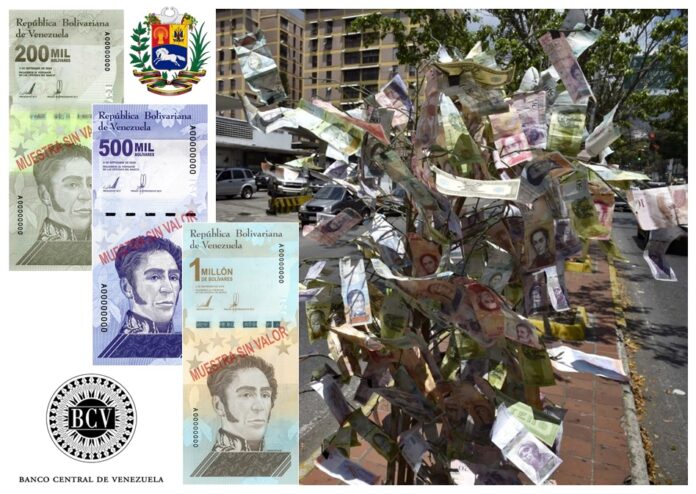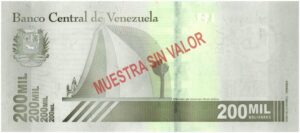
As Venezuela’s economy shrank exponentially for a seventh straight year and the prospects do not look any better for 2021, the country’s Central Bank have introduced on the 8th March three additional higher denomination banknotes into circulation to ease purchases which require physical currency. The Banco central de Venezuela published a statement on its website on the 5th March 2021 where they posted illustrations of the new 200,000, 500,000 and 1,000,000 bolivares notes stating they were being introduced into circulation to “fulfill the current economy’s requirements” but offered no further details. With the introduction of the 1,000,000 bolivares denomination, they are now the largest in the nation’s history but with an exchange rate of 1,889,184 to one US dollar, they are worth just 0.50 USD.
The last change or addition of larger denominations was in June 2019 with the introduction of 10,000 – 20,000 and 50,000 bolivare banknotes, the largest of the three being equal in value of 8.30 USD. Prior to this move, the Banco Central re-calibrated their beleaguered, hyper-inflated currency in August 2018 by removing five digits from the system and issuing eight new denominations from 2 to 500 bolivar sobranos, the currency’s new name.
It was reported by several news sources that Venezuela’s Central bank imported banknote security paper in October 2020 and planned to issue a 100,000 bolivares banknote. However, with the sky-rocketing level of the country’s inflation – which stands at nearly 3000 percent, the denomination soon became impractical just during the planning stages. Most Venezuelans refuse to accept their own country’s currency owing to the fact the currency soon loses any purchasing power. As the government continues to turn a blind eye to a growing number of dollar transactions – more than sixty percent of cash transactions are made in some foreign currency, the necessity of actual bolivare banknotes is needed for a variety of local transactions. For months, the metro-subway in Caracas began letting passengers ride for free as there was no electronic payment system in place and few passengers carried bolivar banknotes sufficient to purchase a ticket. They recently installed a new card payment system but for those who do not have access to a bank account, they must still rely on cash purchases. Cash is also needed in order to ride the network of buses and purchase subsidized fuel. Most Venezuelans avoid carrying huge sums of banknotes for even the smallest shopping and utilize electronic methods of payment but as the country suffers repeated power outages daily, these methods are often impaired. Venezuelans also hold other foreign currencies, and this is dependent on whether they are closer to Colombia or Brazil as many will cross these borders to buy food and medicine.
Disputed President Nicolas Maduro and his administration which have had international sanctions applied to the government and individual members of his internal circle by the United States and the European Union has committed the country to a fully digital economy this year. Following three years of hyperinflation now topping out at over 3000% annually and since the last introduction of the re-calibrated bolivar currency in 2018, the move to remove physical currency from use in favour of an online system may solve the need to print and mint banknotes and coins. However the overlying issue of the interventionist policies of Maduro and his socialist predecessor, the late Hugo Chavez who was president from 1999 until his death in March 2013 are for many critics of the Maduro regime the core reasons of why the country has suffered this decades-long economic melt-down.
A combination of socialist economics of subsidized prices and wages, controlled production of consumer goods due to lack of hard currencies to pay for raw imports and commodities have turned their once-thriving market economy into “chavista” chaos. The once-prosperous South American country – with oil reserves believed to be larger than any found in the Middle East has been transformed into a land of desperate people of which more than ten percent of Venezuelans have become economic refugees over the last decade.
The three new banknote values are uniform in size at 156 / 69 millimeters and are dated “3 DE SEPTEMBER DE 2020”. Their design is vertically oriented on the obverse and horizontally formatted on the back or reverse side. All three denominations feature national hero and liberator Simon Bolivar on the front side. As part of the overall design, the denominations 200,000 and 500,000 bolivars are represented with the word “MIL” after the first three numerals. Their reverse design includes an illustration of the Liberator’s mausoleum which is integrated into the National Pantheon. The 1,000,000 bolivare notes depict a commemorative image of the Battle of Carabobo, decisive in the War of Independence and which celebrates its bicentenary anniversary in 2021. As part of the overall design, the denomination is represented by the word “MILLON” rather than six zeros after the numeral 1.
Security features common to all notes:
- An image of Simon Bolivar is located at the right top of each note and is a replicated image of the primary image featured.
- Segmented security strip. Shown segmented on the front side, the strip appears as a solid line when held up to a light source. Each strip also includes the see-thru text BCV.
- Flourescent fibres. Dispersed throughout the security paper, small fibres can be seen as fluorescent under a UV light source.
- Aligned – perfect registry. The initials BCV appear as partial design on the obverse, when the note is held up to a light source, the initials appear complete with the print applied on the back.
500,000 & 1,000,000 Bolivares:
- Tactile print. The print of the portrait of Simon Bolivare can be felt by the fingertips as well as the text REPUBLICA BOLIVARIANA DE VENEZUELA placed at the top of the notes.
- Latent image. Below the portrait of Simon Bolivar, the initials BCV can be seen within the decorative box when the note is tilted under a source of light.
For additional information on the coins and banknotes issued by the Banco Central de Venezuela, please visit their website.
Here you can view the coins and banknotes Venezuela introduced 2018.
A million Bolivares is nothing compared with Zimbabwe’s older denominations that arrived at hundred trillions in 2016!
The author, Michael Alexander, is president of the London Banknote and Monetary Research Centre.









